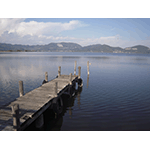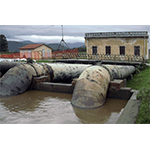Lake Massaciuccoli
In the past, Lake Massaciuccoli had a greater reach which also included an extensive swamp area that was the frequent cause of malaria. The hydraulic problems tied to this environment were already confronted by the Romans, and as of the 14th century were targeted several times with various projects which did not obtain the desired results. In the first half of the 18th century, mathematician Bernardino Zendrini from Venice thought that the best solution to reclaim the area was to prevent the fresh water of the lake from mixing with the salty sea water. For this reason, in 1741, he built floodgates between the lake and the port of Viareggio, which partially reclaimed the environment, though vast areas remained to reclaim, becoming the object of study by famous hydraulic engineers like Tommaso Perelli, Leonardo Ximenes, Giuseppe Ruggero Boscovich and Eustachio Zanotti.
In the early 19th century, Lorenzo Nottolini proposed a project that connected the basin of Bientina with that of Massaciuccoli. With a single solution, Nottolini sought to solve several urgent hydrographical problems, such as the recurrent flooding of the Serchio by reclaiming Lake Bientina and filling Massaciuccoli Swamp. The "Grand Project" – as contemporaries defined it – provided for diverting the course of the Serchio from Lucca towards Migliarino. The river in full spate, loaded with detritus, would have favoured filling the area of Massaciuccoli. Finally, a canal which was supposed to join Lake Bientina with the Serchio River, its bed by now free, would have emptied the lake itself. The project was not carried out due to the enormous costs, as well as to bureaucratic problems, as part of the area affected by the work concerned both the Duchy of Lucca and the Grand Duchy of Tuscany.
The extraction from the lake bed of a precious siliceous sand, used in the building and glassmaking industries, began as of the mid 19th century.
Only in the 20th century were vast wetland areas reclaimed in the Massaciuccoli area, which is today part of the nature reserve of Migliarino-San Rossore-Massaciuccoli.
****************************
Texts by Graziano Magrini
English translation by Victor Beard
Last update 20/gen/2011





